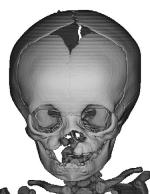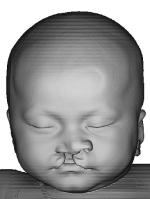Cleft lip research benefits Malaysian infants
 Dentistry Dentistry
A leading Malaysian craniofacial scientist is paving the way for the better diagnosis and treatment of Malaysian babies born with cleft lip and palate conditions. Dr Zainul Rajion, who is a lecturer at the School of Dental Services at Universiti Sains Malaysia (USM), graduated with his PhD in Dentistry at the University of Adelaide's graduation ceremony held in Kuala Lumpur last month. For his University of Adelaide PhD, Dr Rajion used high-tech three-dimensional Computer Tomography software, or 3DCT, to conduct detailed scans on Malaysian babies born with cleft lip and palate (CLP). His PhD was done in conjunction with the University of Adelaide's Dental School, and the Institute of Craniofacial Study (ICFS), which is part of the Australian Craniofacial Unit at Adelaide's Women's and Children's Hospital. Having returned to USM's Kota Bahru campus last year, Dr Rajion is furthering his research in this important health area, and is also now passing on his craniofacial science knowledge through his teaching of USM dental students. "The prevalence of CLP in Malaysian babies, particularly in Kelantan State, is very high - somewhere in the order of one in every 500 to 600 live births," Dr Rajion said. "Previously, it was thought that babies with CLP only had deformity and problems in that particular area of the body. But the data I collected showed that most of these babies also suffered other medical problems such as aspiration pneumonia, a chest infection caused by the baby not being able to swallow in a coordinated way. "It will now be easier for doctors to treat and diagnose CLP babies as they will know to fully investigate all areas of the body and not just the area of the CLP defect." Using CT technology to give a detailed analysis of the severity and extent of deformities of CLP has provided insight into the biological basis of the condition, Dr Rajion said. "My investigation has also highlighted the existence of a greater range of craniofacial anomalies in CLP babies than previously thought, and this will assist doctors in the management of affected infants," he said. More broadly, Dr Rajion's research also highlights how Malaysian and Australian education, research and health institutions can join together to achieve significant and lasting outcomes.
"The USM has identified craniofacial science as one of its areas of excellence, and have been sending postgraduate students like myself overseas to pursue research at a PhD level," Dr Rajion said. "At USM, we have had a long-term collaboration with the University of Adelaide as it is known internationally for its strength in research and teaching. I chose Adelaide over other Australian universities because it had a program which suited my needs, and its degree is recognised worldwide." Dr Rajion, along with his supervisors at USM, the University of Adelaide and ICFS, has already published several journal articles regarding his findings, and he has also spoken about his research at international conferences. "My supervisors were absolutely committed in helping and guiding me," Dr Rajion said. "They nurtured my interest in medical and dental science and fuelled my passion for research work. "I've been given a very big responsibility for USM's bid to excel in the area of craniofacial science in Malaysia, and my experiences in Adelaide will definitely help me." Story by Ben Osborne
|







